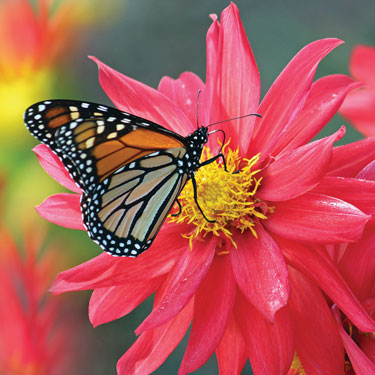Safe swan plants for spring Monarchs
Here’s a few tips to help newcomers to raise successful butterflies;
Two weeks after an egg is laid the Monarch caterpillar (or larva) will grow almost 3000 times in size. Plus these little creatures browse the foliage, eating a bit here and a bit there and wasting a lot of leaf.
- Between egg and chrysalis the caterpillar or larva is going to shed its skin five times. When they are shedding their skin it is important not to disturb them. We suggest that you observe the life cycle but do not touch or interfere. Monarchs have been undergoing metamorphosis for hundreds of years and do not usually need our help.
- If your larvae need more food we suggest you let them move themselves to the new plant. A potted plant can be placed next to an existing plant. Or, if the existing plant has no leaves, then prune it and put the stems you have cut off (with caterpillars) at the base of the new plant.
- Did you know that milkweed and Monarchs are poisonous? Thus it’s important to be careful when handling them. Monarch larvae store toxic steroids (known as cardenolides) from the milkweed they eat and use these cardenolides as a defence against predators such as birds. The bad taste and toxicity of both the larvae and adults are advertised by their warning colour.
When a bird predator tastes a Monarch it learns to associate their colour and pattern with the bad taste and avoids preying on them in the future. Interestingly, the Shining Cuckoo is not affected and will eat them. So please consider the following…
- There are different types of milkweed and the new plant(s) may not immediately appeal to your larvae. Water the plant well so that if there is an imbalance of cardenolides, they will be diluted.
- If you are buying new plants as food for your caterpillars you should ensure they don’t have pesticide spray residue on them as this will affect and may even kill your brood. Ask your supplier if they are spray-free – or better yet have a go at planting next year’s in advance from seed.
- Pesticides include fly sprays, plug-in insect controls and flea collars on pets, something to remember if you thought you would bring your Monarchs indoors.
- If you are concerned that your caterpillars are dying we suggest that you look for similar reports, or add your own post. Don’t forget to add details like your locality, if the plants or new or well-established, number of caterpillars affected, if you have neighbours who spray and anything else you think is relevant.
Written by Jacqui Knight for Moths and Butterflies of New Zealand Trust. Photo by Sally Phillips. For more information about Butterflies or to become a MBNZT member please visit www.nzbutterflies.org.nz.
2-Nov-2014

Monarch butterfly by Sally Phillips

